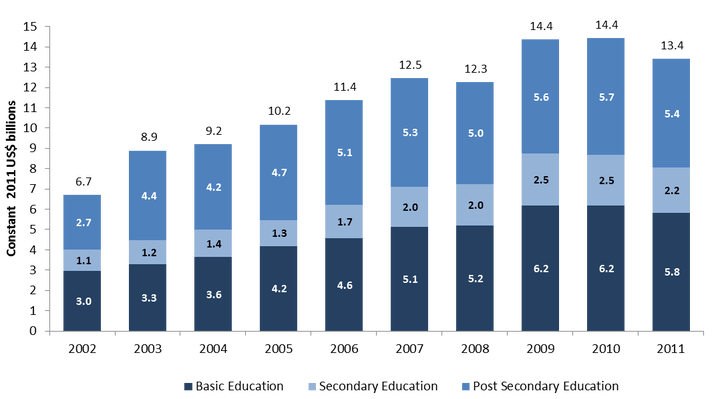Millions of children may be denied access to school due to reductions in aid, according to new data released today in a new policy paper from the EFA Global Monitoring Report team and the UNESCO Institute of Statistics (UIS). The paper shows that progress towards universal primary education has stagnated, while international aid to basic education has fallen for the first time since 2002. Less than 1,000 days before the 2015 deadline to achieve universal primary education, 57 million children remain out of school.
Number of out-of-school children by region, 2000-2011

After pledging to achieve universal primary education at the World Education Forum in 2000, the world made great progress in reducing the number of out-of-school children from 102 million to 70.5 million. Progress stagnated in 2005, however, and out-of-school numbers dropped only slightly from 59 million in 2010 to 57 million in 2011. If this rate continues, we will be far from our goal in 2015, as highlighted in a video presenting the latest data.
The greatest progress has been made in South and West Asia, where the number of out-of-school children has fallen from 38 million to 12 million. Sub-Saharan Africa, on the other hand, continues to face significant challenges: the region has nearly 30 million out-of-school children, only 3 million fewer than in 2005. One in five primary school-age children in the region have either never been to school or left before completing their primary education.
While many children never attend school at all, a significant number leave school early. In 2011, about 25% of all children left primary school before reaching the last grade, often lacking basic literacy and numeracy skills. By identifying whether children are out of school because they have dropped out, not yet entered, or are never expected to attend, policymakers can better target interventions where they are most needed. For example, in areas where the majority of out-of-school children have dropped out, programmes should focus on improving the quality of education and reducing costs to families.
The paper also looks at which children are least likely to be in school. In a study of household survey data from 57 countries from 2006-2011, we found that the average rate of out-of-school children varied greatly among children from different regions and groups:
- 31% of children from poor households are out of school compared with 9% from wealthy households;
- 23% of children in rural areas are out of school compared with 12% of urban children;
- 21% of females are out of school compared with 20% of males.
Quality schools and teachers are urgently needed to reach the most disadvantaged populations. However, the funding for such interventions is unlikely to materialize in the current aid climate. New data by the EFA Global Monitoring Report show that donors are cutting back spending on education just when it is needed most for the final push to reach the most disadvantaged children by 2015. Six of the 10 largest bilateral donors cut their aid to basic education between 2010 and 2011. The Netherlands and Japan both cut aid to basic education by nearly one-third, and Canada's aid dropped by 21%. In addition to the bilateral donors, the European Union also decreased its aid to basic education by nearly one-third in the same period.
Several donors have helped to compensate for the loss by increasing their aid to education, including Australia, Germany, Sweden and the United Kingdom. The United Kingdom made the largest increase, in part due to the country's commitment to meet the European target of devoting 0.7% of gross national income to international aid. As a result, the United Kingdom is now the largest bilateral donor to basic education, taking the place of the United States. The result is still a net loss, however: total aid to basic education declined by 7% between 2010 and 2011.
Total aid to education disbursements by US$ billions, 2002-2011

Donors are also failing to channel aid to those who are most in need. Of the $5.8 billion in aid to basic education in 2011, only $1.9 billion was allocated to low income countries. Many donors are not prioritizing low income countries, which face the greatest challenges in achieving universal primary education. Only three of the 10 countries with the highest numbers of out-of-school children are among the top 10 recipients of aid to basic education: Ethiopia, India and Pakistan. Nigeria, which has the largest number of out-of-school children, is not among the top 10 aid recipients and saw its aid decrease by one third between 2010 and 2011.
Action is urgently needed to reach the 57million children who remain out of school by 2015. To fill the $26 billion annual finance gap for basic education, we recommend that donors meet their target aid commitments and prioritize basic education. In addition, we believe that the new post-2015 goals should include a specific target for financing by aid donors. Education for all children can be achieved, but not by a few key players: it will require strong commitments and action from everyone.
